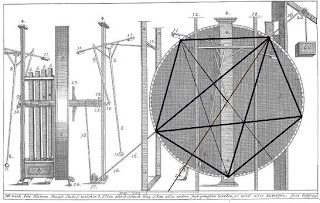I've been interested in Johann Bessler and his wheel since I was about fifteen years of age, when I read Rupert Gould's account of him in his book 'Oddities'. At that time I dreamed of the possibility of building a similar machine, however I knew already that science said they were impossible, I dreamed and speculated and drew hundreds of designs, but I said nothing to anybody.
At the age of about 28 I chanced upon a copy of Gould's book, 'Oddities', and I was struck anew by the quality of the narrative and the evidence described and how utterly convincing it was. I resolved to research the subject as thoroughly as possible even if it took me the rest of my life. In the intervening years I occasionally told people about him and about my ambition to reconstruct his wheel - and quickly got used to the scorn and laughter which erupted at my articulated aspirations! It seemed to me that Gould himself was sufficiently fascinated by the story to do some research and in my opinion became convinced of the inventor's sincerity.
But Gould was not alone; I've always thought how remarkable it was that Henry Dircks, author of the two compact volumes detailing the history of the seach for Perpetual Motion, should have spent some twenty years researching every single mention of the subject and reproducing them in his books, complete with drawings of numerous failed designs. Then there is Arthur Ord-Hume's book on the subject, another accountof the history of such machines. Like Dircks, Ord-Hume was an engineer, and like Gould wrote extensively on antique clocks and other mechanisms. Was it simply interest that drove these authors to spend years researching the subject - or was there a discreet longing to believe; to discover the secret apparently found only by Johann Bessler?
John Rowley was another one. He was Master of Mechanics to King George 1st and held a reputation as the finest instrument maker in England, and praised as such by none other John Harris, inventor of the Marine Chronometer which eventually won the prize offered by the British Board of Longitude for providing a means for finding a ship's longitudinal position at sea. Rowley spent his remaining years trying to duplicate Bessler's wheel having seen it during a visit to Kassel.
These men, all experts in their fields, seem to have been drawn to studying Perpetual Motion, and even if some of them declared their scepticism publicly, I have a feeling that privately they were not so cynical and perhaps yearned to discover that there was a way to achive the impossible.
My own suspicion that the historical accounts were wrong in assigning Bessler to the ranks of the fraudulent and the criminal, was first roused when I read Gould's account of the reported actions of Bessler's maid. She stated under oath that she was forced to turn the wheel by means of a secret lever from the adjoining bedroom. I simply did not believe that it was possible to turn a wheel measuring twelve feet in diameter and eighteen inches thick, by means of a simple system of levers which she said, applied their force to the quarter inch bearings at the ends of the axle. As if this wasn't enough she also claimed that she was able to turn the wheel which lifted the 70 poinds weight from the castle yard to the roof several times!
One of the problems we seem to encounter regularly is the intransigence of all those we ask to reconsider the evidence. No one will do that because they believe it would counter certain physical laws - it won't, but until the reason is explained and made clear they will continue to dismiss all such claims.
To repeat myself - only a working model will do it.
JC
10a2c5d26e15f6g7h10ik12l3m6n14o14r5s17tu6v5w4y4-3,’.

.jpg)










